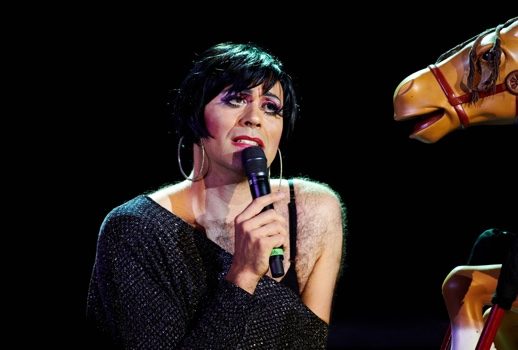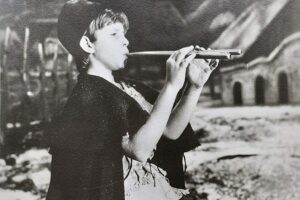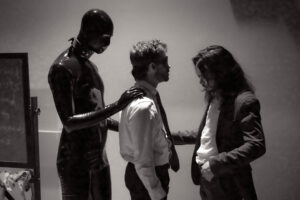

Martha Graham Cracker headlines “a truly original potpourri.”
Opera Philadelphia’s O18 Festival continues through the weekend, but Friday represented a finale of sorts with the last two premieres: a recital from a pair of exceptionally promising Curtis singers in the afternoon, and the last of three cabaret evenings showcasing international diva Stephanie Blythe and Philly’s own drag icon Martha Graham Cracker.
Soprano Ashley Marie Robillard and mezzo Siena Licht Miller returned to Curtis’s Field Concert Hall for the second of two recitals built around the theme of travel. The first focused on adventures in Europe; this time, we had a look at the United States.
Provocatively, the joyful impetuousness that defined travel abroad was largely absent here. Instead, we explored an America that was nostalgic, sometimes somber, and occasionally angry. Texts this time—by Langston Hughes, Walt Whitman and others—took a sometimes harsh look at our history. Purely by coincidence, this was the day the Senate Judiciary Committee met to deliberate the Brett Kavanaugh situation.
As in last week’s concert, Ashley Marie Robilliard’s spring-fresh soprano and Siena Licht Miller’s sensual lyric mezzo glowed with vocal health, and the two again proved fine interpreters across a wide-ranging and demanding program. Each had a “big moment” that she made her own.
Robillard’s was Barber’s Knoxville: Summer of 1915, which had the right balance of youthful innocence and mature awareness. Miller brought exceptional insight to John Musto’s “Refugee Blues,” a devastating setting of W. H. Auden’s poem about displaced German Jews in World War II.
But what I liked best was a duet arrangement of Weill and Brecht’s “Alabama Song,” which brought out each singer’s special qualities—Robillard’s verse tart and satirically pointed; Miller’s lush, louche, and dripping with innuendo.
Some things you won’t find at the Salzburg Festival:
- Stephanie Blythe singing “Recondita armonia,” “M’appari,” and several phrases from “Rose’s Turn.”
- A hairy drag queen explaining Grindr.
- And the Opera’s General Director and President decked out in an elegant dark suit complemented by diamond earrings and a snazzy necklace.
Frankly, I had my doubts going into Dito and Aeneas, the third and final installment of a trilogy that brought together Blythe (in semi-drag as tenor Blythely Oratonio) and Dito van Riegersberg (also in drag as alter-ego Martha Graham Cracker). The first two evenings were sometimes fun but a mixed bag, and I wondered if the concept had played itself out.
Happily, the third time’s the charm. In every sense—musically, theatrically, and simply as An Event—Dito and Aeneas was by far the best of the three evenings: a truly original potpourri that no one who attended will likely forget.
Blythe of course took the vocal honors—she’s not only one of our finest mezzos, but on the evidence of this, ready to take on leading tenor roles, too. (Just in time, to judge from Roberto Alagna’s Samson at the Met’s opening night.) But Martha also acquitted herself well and sang with real style.
The patter was divinely droll (credit writer and director John Jarboe); the musical mashups inspired (Daniel Kazemi, who also accompanied on keyboards and conducted with real style); and by the time we segued from “Where’re You Walk” (Stephanie) and “When I Am Laid in Earth” (Dito) to the encore of duet of “Enough is Enough,” I was ready to follow them anywhere.
So O18 ends… and the Monday morning quarterbacking inevitably begins.
I need more time to truly process what I’ve seen. My preliminary sense is that O17—the first Opera Philadelphia festival, which introduced six operas (including three world premieres)—remains the benchmark for ambition. But O18 felt smoother and even more glamorous, and surely takes the palm for boldly reconceptualizing opera for a new audience and a new era.
In particular, I’ll remember two final moments, one from each of the last two events, that sum up what O18 has meant.
The first was the long kiss between Blythely Oratonio and Martha Graham Cracker near the end of Dito and Aeneas. It drove the crowd wild, and really captured the energy, panache, and genre-defying, out-of-the-box invention that has defined the festival.
The second was quieter, and—to me, at least—more powerful. Frederica von Stade was in attendance at the Miller/Robillard recital. She slipped in unobtrusively, and throughout was a model audience member, deeply focused on the artists who were performing. Throughout, she beamed, and her final applause was exceptionally enthusiastic.
Thus was a torch passed between the greatest lyric mezzo of her generation—a sensational singer whom I first heard when I had just graduated high school, and one whose artistry helped me discover the glory of opera—to a pair of younger artists who will surely do the same for some high schoolers now.
Today, I feel grateful to live in Philly.
Photos by Dave DiRentis for Opera Philadelphia

























Comments